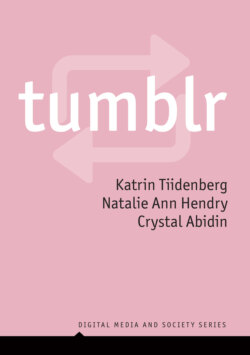Читать книгу Tumblr - Tama Leaver, Crystal Abidin - Страница 22
Interaction
ОглавлениеBy 2020, tumblr had multiple features for users to interact with each other, developed and rolled out at various moments in time. In 2009, the “submissions” feature was introduced, allowing other users to submit posts for publication on someone else’s blog (staff 2009). Each blogger can choose which format they accept submissions in, and whether or not to publish sent submissions. When introducing submissions, tumblr linked the feature primarily to artists submitting their artwork; however, it has been used by many other groups, including the NSFW communities, where soliciting and sending nudes via submissions was common. Another early (2010) feature of interaction on tumblr was “asks.” tumblr users can set their asks to accept questions and comments anonymously or only from other tumblr users. At times, anonymous asks are used by those who read and follow tumblr blogs via a browser and do not have an account themselves. At other times, tumblr users choose to anonymize themselves specifically for using the asks, either to ask embarrassing questions, to joke, or (more rarely) to be mean. Because of the gray anonymous user icon accompanying such asks, the vernacular name for anonymous ask senders is “Grayfaces.” Asks are responded to by publishing them with an answer, or by responding to them in private. In both cases, the original message disappears from one’s asks, which complicates conversation. In the early 2010s, it was common for people to start interacting via asks and then move the conversation off tumblr, into email or a separate chat app. Asks was explicitly framed by tumblr staff as “a one-off Q&A, not a two-way conversation” (tumblr Help Center 2020a) linking it to their vision of tumblr as a space for creators, who are bound to have followers or fans. The latter brings us to yet another interactional feature, rolled out in 2010 – “fan mail.” This allowed users who had followed someone for at least forty-eight hours to leave feedback, which, unlike asks and submissions, could not be published, and, unlike privately replied asks, stayed in the receiver’s mailbox after being responded to. Fan mail was described as a “private commenting system between the blogger and the reader, that doesn’t involve other visitors” (Panzarino 2012). Finally, in 2015, after years of requests from users, “messaging” was introduced. Messaging is only possible between logged-in users and cannot be anonymous. Fan mail was later discontinued in favor of messaging.
In November 2019, tumblr rolled out “group chats,” which are only available on the mobile app. To some user criticism, group chats are public by default and cannot be set to private. Anyone can see messages within the chat, but to be able to send messages, one has to be approved as a member. Group chat messages expire after twenty-four hours, seventy-two hours, or a week, as chosen by the group chat “owner.” All mobile chat groups have to follow tumblr’s central Community Guidelines, although some have additional rules described in the chat description (e.g., “feel free to observe or participate, don’t worry, we don’t know what we’re doing either”; “DM your information to get accepted”). Group chats hold a maximum of two hundred participants, and the more popular chats often migrate to Discord servers to allow more people in, and because “chat functions in tumblr are super basic” as reported to us by a moderator in a group chat we observed. tumblr’s aim in adding this feature seems to be to allow “niche communities” to “create dedicated spaces to talk about their interests instead of simply reblogging someone else’s post” (Alexander 2019). Uploading images and GIFs is not possible in group chats. The conversations in the group chats we observed usually consist of sharing links to tumblr posts, memes, or Archive of Our Own fanfiction stories, and discussing those. Parody chats (e.g., “we all pretend to be middle-aged moms”) only discuss issues in character. A user only sees the chats they are part of and those recommended by tumblr, while a directory of all group chats is not available at the time of writing.
Finally, it is important to understand how the “reply” function differs from the typical (public) commenting feature. David Karp has expressed a view that comments bring out the worst in people (Walker 2012), so he purposefully omitted that functionality, articulating reblogs, fan mail, or replies as its substitutes in various interviews. Replies were introduced as beta in 2010 and were generally loved by users. They were discontinued in 2015 to roll out messaging, but brought back in 2016. Bloggers can choose whether they want to enable replies. In the early years, a blogger had to turn replies on from the settings menu. Now, a user can select who they want to be able to reply to their posts (everyone, those whom one follows, or those who have been following one for at least a week). Replies are only available to logged-in users via the dashboard. tumblr’s Help page describes replies as a “way of responding to a post that’s more specific than a like, less of a commitment than a reblog, and more public than a message” (tumblr Help Center 2020b).
